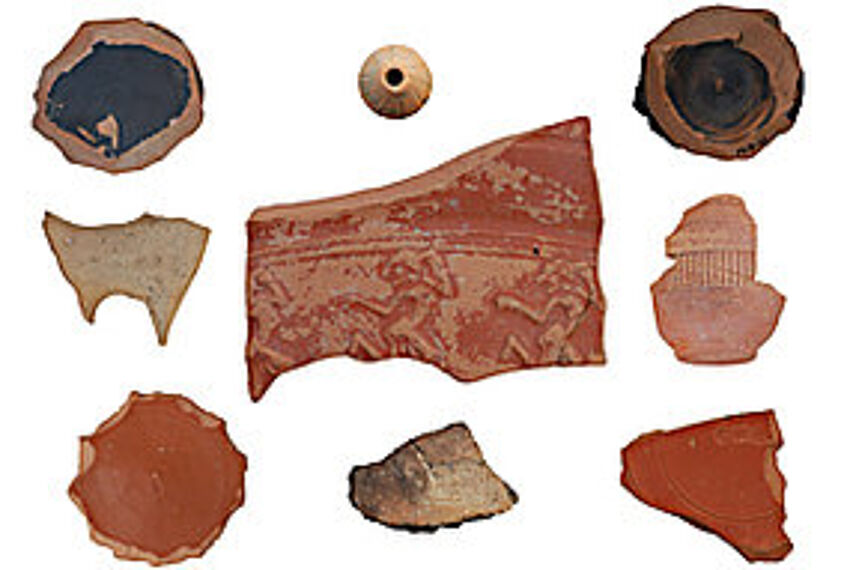Ausgrabung Il Monte (San Gimignano, Siena, Italien) Bericht über die Forschungen in den Jahren 2005-2010
Project description
Il Monte is an agricultural field used for cereal cultivation, which opens to the southeast towards San Gimignano and is about 8 km away from there. About 1.5 km north of the site is the “Villa del Monte”, to whose property the field also belongs. So far, an area of around 0.5 ha has been surveyed; members of the Gruppo Archeologico di San Gimignano (Giacomo Baldini, Claudio Sangiolo) have recorded surface finds from an area four times as large. In February 2005, an area of approx. 10,000 m² (fluxgate magnetometer) and 800 m² (caesium magnetometer) was examined geophysically by Dr. Tim Schüler from the Thuringian State Office for Archaeology on behalf of the Friedrich Schiller University in Jena.

Foto: G. Schörner
An area of smaller structures was found in the northeast and an agglomeration zone in the middle of the study area, the so-called “area centrale”, which also yielded the most surface finds. According to T. Schüler's interpretation, these central anomalies point to a structure embedded deeper in the ground. This is important insofar as the architectural remains are probably deeper than could be reached (and destroyed) by deep plowing. In the south of the investigation area, a zone with more regular structures could be cut, as well as a circular formation in the east, but the investigation could not be continued due to the bad weather in 2005. In principle, the geophysical investigations indicated a larger complex of structures.
The initial assessment of the 'Il Monte' site was based primarily on the rich find material on the surface. Based on the interpretation pattern commonly used for surveys in recent years, Il Monte was interpreted as a well-equipped villa or possibly as a rural settlement site (vicus) with individual architectural elements and decorative details (wall paintings, mosaics, marble cladding etc.), because tesserae of a mosaic decoration and a trapezoidal piece of white marble - probably the remains of an opus sectile floor - were found. However, more detailed information on the actual architectural design was to be obtained in the 2006 campaign through corresponding smaller sondages.
The interpretation as a settlement site with an elevated social status was confirmed by the ceramic material. In the course of the inspections in 2004 and 2005 by the Gruppo Archeologico di San Gimignano, a total of over 300 diagnostically important fragments (floors and rim sherds) were collected. An initial inspection of the fine pottery in February 2005 revealed the following picture: In chronological terms, the Bucchero sherds, as the earliest material, probably still belong to the 6th century BC, while the youngest fragments (Terra Sigillata Chiara D) date from the 4th or 5th century AD. Among the significant fragments of terra sigillata, several common types of Italic production from the late 1st and early 2nd century AD could be identified. In principle, vessels of regional manufacture predominate, with a slight preponderance of late forms, i.e. terra sigillata tardo talica of the middle and late 1st and 2nd centuries AD.
As with the geophysical prospection, two focal points were identified in the area of surface finds, the so-called “area centrale” and a second concentration of sherds and other finds a little further down the slope to the south. In principle, Il Monte can be regarded as a settlement site with a very long period of evidence from the Etruscan period to Late Antiquity. It therefore seemed particularly suitable for an excavation aimed at researching the history of rural settlement in the northern Etruscan interior and, in particular, the transformation processes during the incorporation of the region into the Imperium Romanum, the supposed decline of agriculture during the High Imperial period and the development from “villa” to “village” or the development at the transition from Late Antiquity to the Early Middle Ages.
Characteristics
What particularly characterizes 'Il Monte' as a site is the find material, which goes far beyond what is documented for a rural settlement. The quantity and state of preservation of the pottery found, in particular fine pottery, are exceptional for a settlement excavation. In 2008, for example, six almost complete terra sigillata plates were uncovered in a fire feature in a very confined space, and this fine red tableware formed a large part of the find material from 2006 to 2008. Overall, the North Etrurian terra sigillata tardo-italica is exceptionally well represented. Particularly important evidence for better knowledge of the distribution channels of this relatively poorly researched ceramic genre - and of course also as dating criteria - are the numerous stamps of this production that were found on 'Il Monte', so that important statements can be made about these workshops of the second half of the 1st century and the first half of the 2nd century AD in Pisa and the surrounding area. The discovery of a new pictorial motif on this terra sigillata tardo-italica, a procession of men with cloaks wrapped tightly around their bodies, probably a procession, is a particularly fine individual result.
In 2008 in particular, a large number of imported ceramics were excavated, which makes the integration of the site into the long-distance trade network of the Imperial period even more evident: on the one hand, a considerable quantity of African terra sigillata of the early Chiara A type was found - almost unknown for the rural area of Etruria - and on the other hand, terra sigillata of southern Gaulish production was also clearly identified, including such rare products as marbled terra sigillata.

Findings: Design H. Wabersich
However, it is not only the higher quality tableware that demonstrates the far-reaching connections beyond Etruria; cooking pots and casseroles were also imported to 'Il Monte' from North Africa. The numerous fragments of transport amphorae, which document the import of foodstuffs from distant regions of the Imperium Romanum, are particularly important from an economic history perspective. In addition to this evidence of a pronounced long-distance trade, there is also evidence of an exchange at sub-regional level, for example the so-called ceramica grigia a vernice nera, which is documented in many fragments, was produced in various places in the Arno valley. Information on the local production of ceramics, which is highly differentiated in terms of the use of different clay deposits and lean particles as well as the production of a wide variety of shapes, can be expected from chemical investigations and analyses based on thin sections.
The majority of the material was pottery, but the range of finds on 'Il Monte' is extended by significant individual objects. For the first time, oil lamps were found in several fragments. Jewelry and costume elements, such as a bronze garment pin and a bone hairpin, were found in various sections. A hanger, probably the handle of a colum, indicates the use of bronze vessels. The two coins from section 8 of 2008 are evidence of money in circulation in rural areas and may indicate that goods not produced locally were actually purchased and did not reach 'Il Monte' elsewhere.
The fundamental significance of the excavations in Tuscany therefore lies not only in the exploration of a rural settlement as the most common but least known type of settlement in ancient Italy, but above all in the discovery of the rich material culture and high standard of living in inland Etruria.

Plan drawing: S. Pasquinetti
Publikationen
- G. Schörner, Leben auf dem Lande, Antike Welt 2008/H. 2, 52-62 (allgemein)
- D. Hädrich, Il Monte, San Gimignano: Untersuchung der dünnwandigen Keramik (ceramica a parete sottile) (Magister-Arbeit Jena 2010)
- G. Schörner, Dinge und ihre soziale Bedeutung: Behavioral Archaeology, Terra sigillata und die Imelda Marcos-Hypothese, in: E. Tietmeyer u.a. (Hrsg.), Die Sprache der Dinge – kulturwissenschaftliche Perspektiven auf die materielle Kultur (Münster – New York 2010) 53-63 (Terra sigillata).
- G. Schörner, San Gimignano (SI), Località Il Monte: rapport preliminare delle ricerche, anno 2009 (concessione di scavo), Notiziario della Soprintendenza per I Beni Archeologici della Toscana 5, 2009 (2011), 386-388 (allgemeiner Bericht)
- P. Attema – G. Schörner (Hrsg.), Comparative Issues in the Archaeology of the Roman Rural Landscape. Site Classification between Survey, Excavation and Historical Categories. 88. Suppl. Journal of Roman Archaeology (Portsmouth/RI 2012).
- (Hrsg.), Leben auf dem Lande. 'Il Monte' bei San Gimignano: Ein römischer Fundplatz und sein Kontext (Wien 2013).
Im Druck:
- G. Schörner, Comparison of surface, topsoil and sub-surface ceramic assemblages: The case of ‘Il Monte’ (Tuscany), in Attema-Schörner a.O., 31-41. (Methodik von Survey und Grabung)
- G. Schörner, Le anfore da trasporto trovate a ‚Monte‘ (San Gimignano): Ceramiche e merci nel retroterra. Colloquio internazionale Empoli 2010 (Amphoren).
- G. Schörner, Cooking in Roman Tuscany: Innovations and traditions, in: Ceramics, Cuisine and Culture: the Archaeology and Science of Kitchen Pottery in the Ancient Mediterranean World, Conference London, Thursday 16th – Friday 17th December 2010.
